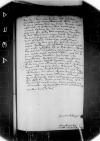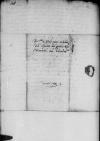Letter #2761
Stanisław HOZJUSZ (HOSIUS) to Ioannes DANTISCUSBrest-Litovsk, 1544-10-07
| received Heilsberg (Lidzbark), 1544-10-27 Manuscript sources:
Prints:
| ||||||
Text & apparatus & commentary Plain text Text & commentary Text & apparatus
Reverendissimo in Christo Patri et Domino, domino
Reverendissime Domine, domine colendissime.
Officiosissimam servitutis meae commendationem.
Miror, quod de bonis Pucensibus tam longo tempore nihil afferatur. A Gedanensibus venit celer nuntius hesterno die, qui mira narrat et futurum hic hodie dicit magistrum Iacobum. A domino
Deum precor, ut Vestram Reverendissimam Dominationem diu servet incolumem. Cuius gratiae me commendo.
Ex
Eiusdem Reverendissimae dominationis Vestrae servitor deditissimus


 BCz 1618, p. 548
BCz 1618, p. 548